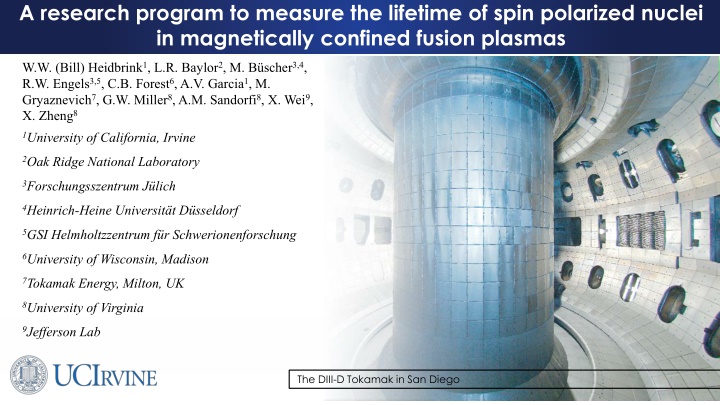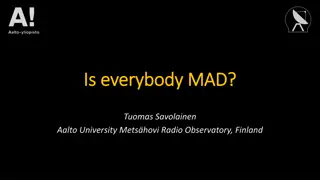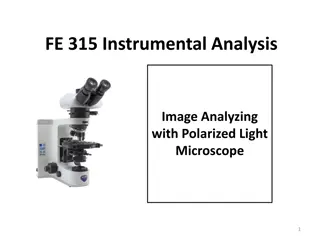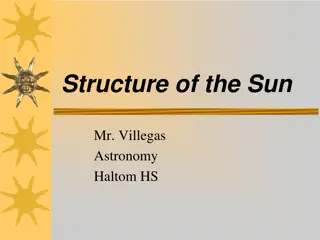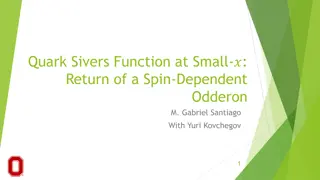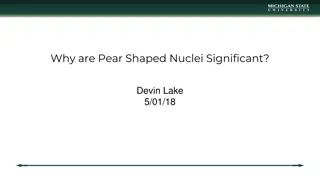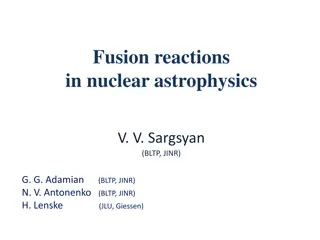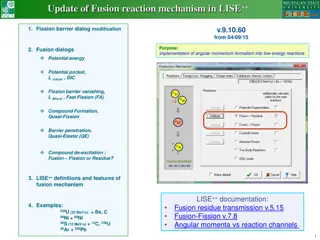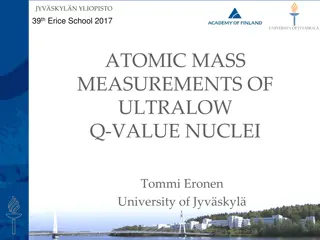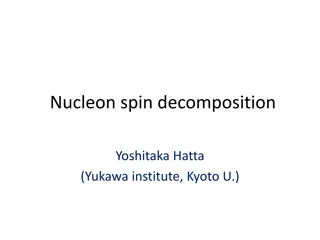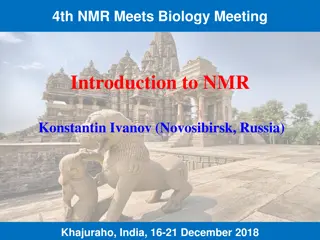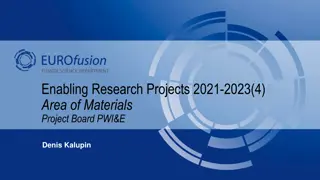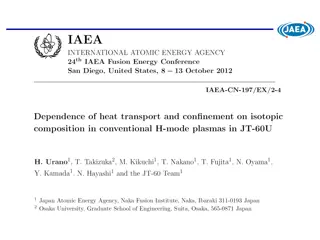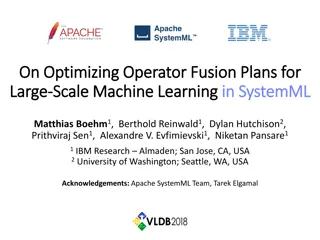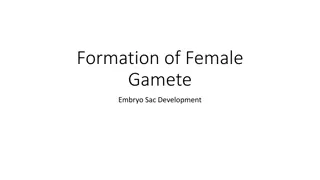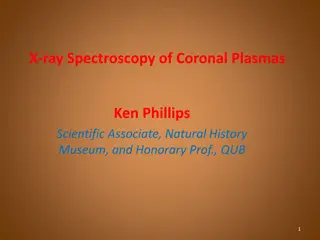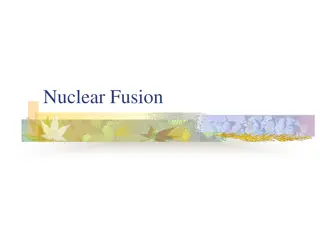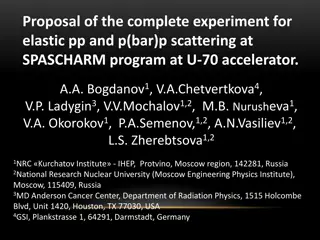Research Program on Spin Polarized Nuclei in Fusion Plasmas
Examination of spin polarized fuel in fusion plasmas to enhance energy production efficiency. Planned experiments aim to measure the lifetime of polarized nuclei for optimized fusion reactions. Key aspects include depolarization mechanisms, neutral beam heating, and fueling techniques with pellets. The potential benefits of spin polarization in fusion energy generation are explored through theoretical analysis and experimental testing.
Download Presentation

Please find below an Image/Link to download the presentation.
The content on the website is provided AS IS for your information and personal use only. It may not be sold, licensed, or shared on other websites without obtaining consent from the author.If you encounter any issues during the download, it is possible that the publisher has removed the file from their server.
You are allowed to download the files provided on this website for personal or commercial use, subject to the condition that they are used lawfully. All files are the property of their respective owners.
The content on the website is provided AS IS for your information and personal use only. It may not be sold, licensed, or shared on other websites without obtaining consent from the author.
E N D
Presentation Transcript
A research program to measure the lifetime of spin polarized nuclei in magnetically confined fusion plasmas W.W. (Bill) Heidbrink1, L.R. Baylor2, M. B scher3,4, R.W. Engels3,5, C.B. Forest6, A.V. Garcia1, M. Gryaznevich7, G.W. Miller8, A.M. Sandorfi8, X. Wei9, X. Zheng8 1University of California, Irvine 2Oak Ridge National Laboratory 3Forschungsszentrum J lich 4Heinrich-Heine Universit t D sseldorf 5GSI Helmholtzzentrum f r Schwerionenforschung 6University of Wisconsin, Madison 7Tokamak Energy, Milton, UK 8University of Virginia 9Jefferson Lab The DIII-D Tokamak in San Diego 0
Spin polarized fuel relaxes the requirements for fusion energy D-T fusion cross-section is increased by 50% when the spins of both nuclei are polarized along the magnetic field1 Due to self-heating, >50% increase in fusion power with no additional requirement on plasma confinement2 Depolarization mechanisms are theoretically weak in the core,1 but the polarization lifetime has never been measured Polarized fuel is now available in sufficient quantities for experimental tests2 [1] R.M. Kulsrud et al., Nucl. Fusion 26 (1986) 1443. [2] L. Baylor et al., Nucl. Fusion 63 (2023) 076009 1
Outline 1. Fusion in contemporary magnetic fusion experiments 2. Spin polarized fuel 3. Depolarization mechanisms 4. Planned & desired experiments 2
Three fusion reactions are often measured in fusion experiments Deuterium is usually the main ion species Many fusion reaction products are unconfined in a moderate- size tokamak Heidbrink et al., Nucl. Fusion 23 (1983) 917 3
Many experiments are heated by neutral beams Inject ~ 80 keV D neutrals Beam ions take O(0.1 s) to thermalize Routinely measure 2.45 MeV neutrons from d(d,n)3He 4
Some experiments are fueled by pellets that ablate & ionize in the plasma Inject frozen D pellets Inject shell pellets with gas inside Typical particle confinement time is O(0.1 s) Electron density Pellet injector above DIII-D L. Baylor et al., Phys. Plasmas 7 (2000) 1878 5
Distinguish between thermal & super-thermal distribution functions Most of the plasma is thermal with ion temperatures Ti of a few keV Neutral beams produce non-thermal, anisotropic populations with O(100 keV) energies Beam-plasma Typical D distribution function f 6
Use D-3He as a proxy for D-T Mirror reaction virtually identical at O(100 keV) energies Fusion products: 14.7 MeV proton 3.6 MeV alpha L. Baylor et al., Nucl. Fusion 63 (2023) 076009 7
Relative reactant energies of ~100 keV are needed for a D-3He experiment Semilog scale ?? ? cross section ?relative speed 8
For adequate count rate, require either 100 keV fast ions or Ti > 10 keV Semilog scale Semilog scale ?? ?? means averaged over distribution functions Beam-plasma Beam-Plasma reactions Thermonuclear Thermonuclear reactions 9
Must use relative measurements of the differential cross section to measure the polarization accurately* D-3He emissivity is ??????? (the reaction rate is the integral of the emissivity over the volume) ??????? Magnetic fusion plasmas are not very reproducible The deuterium density ?? is known to ~ 10% accuracy The helium density ??? is known to ~10% accuracy The ion temperature ?? is known to 5-10% accuracy large uncertainty in ?? Uncertainty in reaction rate > effect of polarization *A.V. Garcia et al., Nucl. Fusion 63 (2023) 026030 10
Use relative measurements of the differential cross section to measure polarization Differential cross section depends upon the tritium (or 3He) polarization ?? & the vector and tensor D polarizations, ?? and ?? ?: angle of emitted fusion product relative to ? ? ? 50% increase in ? if both maximally polarized (PT = ?? No change in total cross section if only one is polarized [If only one polarized] must be ?? ?= 1) ? The relative change in emitted perp/parallel fusion-product signal is sensitive to polarization isotropic Persistence of polarized signal lifetime measurement L. Baylor et al., Nucl. Fusion 63 (2023) 076009 11
Outline 1. Fusion: Use D-3He differential cross section to test 50% enhancement in D-T cross section 2. Spin Polarized Fuel 3. Depolarization Mechanisms 4. Possible experiments 12
Deliver deuterium as a solid 7Li-D pellet* Cryostat for e-beam bombardment of LiD pellets Use dynamic nuclear polarization to transfer spin polarization from electrons to nuclei to align the D spins. Electrons are aligned in a strong B field at low temperature Microwaves drive a hyperfine transition that transfers spins to D nuclei. Use lithium to avoid high Z contamination of the plasma Use 7Li to avoid background fusion reactions Spin transfer occurs on multi-hour timescale Need cryogenic (<4K) pellet gas gun to interface with polarizer Target: ?? ? ??% & ?? ~ 1020 D nuclei ? ??% Xiangdong Wei, Wed. 11:30 *L. Baylor et al., Nucl. Fusion 63 (2023) 076009 13
Deliver 3He as a shell pellet* Photograph of amber GDP pellet Hybrid spin-exchange optical pumping polarizes the 3He at high temperature Polarized fuel is transferred to a glow-discharge polymer (GDP) capsule Relaxation time is 3 days at 77K Target: ???? ??%@ 25 atm ~10193He nuclei ? MRI images of 3He permeating a GDP capsule *L. Baylor et al., Nucl. Fusion 63 (2023) 076009 0 8.5 min 14
An intense polarized neutral beam is desirable Sona-like transition In neutral frame, rapidly changing ?? is an RF wave at precession frequency that provides radio-wave pumping within the Zeeman splitting Hope to test at Tokamak Energy Schematic of test apparatus Target: O(1019) polarized D or 3He nuclei per second Polarized beams would: simplify DIII-D experiments enable experiments on small flexible devices Large gradient aligns nuclei Faatz, Today 15:00 Kannis, Tuesday 9:00 Ciullo, Tuesday 12:00 Measure polarization 15
Outline 1. Fusion 2. Spin Polarized Fuel: Exists in quantities sufficient for a DIII-D experiment 3. Depolarization Mechanisms 4. Possible experiments 16
Two mechanisms can cause depolarization: resonances at the precession frequency & hyperfine interactions Deuterium precession frequency is 0.43 ??? 3He precession frequency is 2.13 ??? proton cyclotron frequency ???= ??/? Hyperfine interactions with bound electrons also a depolarization mechanism. Nuclei in a hot plasma are fully ionized, so this mechanism is irrelevant 17
A fusion plasma is filled with waveswont they depolarize the nuclei? Decreasing Spatial Scale; increasing frequency Fluid (MHD) instabilities Thermal- gradient driven instabilities Fast-ion driven instabilities Coulomb collisions In detailed calculations*, Kulsrud et al argue that depolarization lifetimes are long but are they right? *R.M. Kulsrud et al., Nucl. Fusion 26 (1986) 1443. 18
Magnetic moment ? conservation is a cornerstone of plasma theory The adiabatic invariant ? = ? /? is conserved as long as: ? ??? ????/? ? ??= ? /??? A very successful plasma theory, gyrokinetics, assumes ? conservation gyroradius The particle orbit and polarization (Bloch) equations are nearly identical: if ? is conserved, the polarization should be too! 19
Experiments can assess most depolarization mechanisms Inhomogeneous static magnetic fields during injection Immerse flight tube in a O(0.1) T field to preserve polarization [1] Gradients too long to cause depolarization [1] Hyperfine interactions during ionization Neutral ground state has no interaction Few % loss for 3He [1] Binary Coulomb collisions Spin-spin, spin-orbit and quadrupole moment interactions predicted negligible[2] Electromagnetic waves Most instabilities too low in frequency Waves near ??? problematic Wall interactions High depolarization rates at metal walls [3] Limited by particle confinement time [1] L. Baylor et al., Nucl. Fusion 63 (2023) 076009. [2] R.M. Kulsrud et al., Nucl. Fusion 26 (1986) 1443. [3] Greenside, Journal of Vacuum Science & Technology A 2, 619 (1984). 20
Outline 1. Fusion 2. Spin Polarized Fuel: 3. Depolarization Mechanisms can be tested in existing facilities 4. Possible experiments 21
Use relative measurements of emitted 3.6 MeV alphas & 14.7 MeV protons to infer polarization* Projected orbits Complication: ? /? changes along escaping orbit Ideal thermonuclear case Adequate accuracy despite: counting statistics realistic polarization fractions orbit uncertainties uncertainty in emissivity profile *A.V. Garcia et al., Nucl. Fusion 63 (2023) 026030 22
Planned experimental scenarios on DIII-D Scenario ??????????? ????????? ??/?? Large sensitivity 1) Ti > 10 keV thermonuclear with H beams and LiD & 3He pellets. Special operating conditions; very hard plasma to make Weaker sensitivity 2) Beam-plasma with unpolarized 3He neutral beam and LiD pellets. Special operating condition; adequate count rate easy 3) Beam-plasma with unpolarized D neutral beam and LiD pellets. D beam injection routine; adequate count rate easy D-D Sensitivity unknown D-D Sensitivity unknown Easy operational regime; adequate count rate 4) Thermonuclear with LiD pellets. 23
With intense polarized beams and/or D-D differential cross sections experiments on many other facilities become feasible Polarized D and 3He injection into WHAM Polarized D injection w/ polarized 3He pellet in Tokamak Energy s ST40 D-D experiment on the Madison Symmetric Torus 24
Conclusions & Opportunities ? 1. Fusion: Use D-3He differential cross section to test 50% enhancement in D-T cross section Spin Polarized Fuel: JLab and UVa are preparing LiD and 3He pellets for injection into DIII-D Depolarization Mechanisms can be tested in existing devices DIII-D polarization lifetime measurements are anticipated in ~ 5 years 2. ?1 ?2 3?? ? 3. 4. Opportunities Provide ~ 1 Amp polarized neutral beam Polarization dependence of D-D differential cross sections at low energy 1) Polarized Fusion and Potential in situ Tests of Fuel Polarization Survival in a Tokamak Plasma, L. Baylor, A. Deur, N. Eidietis, W.W. Heidbrink, G.L. Jackson, J. Liu, M.M. Lowry, G.W. Miller, D. Pace, A.M. Sandorfi, S.P. Smith, S. Tafti, K. Wei, X. Wei and X. Zheng, Nucl. Fusion 63 (2023) 076009. 2) Conceptual design of DIII-D experiments to diagnose the lifetime of spin polarized fuel A.V. Garcia, W.W. Heidbrink and A.M. Sandorfi, Nucl. Fusion 63 (2023) 026030. 25
Backup 26
Backup 27
What about a reactor? Q: (70% D) * (65% 3He) only increases the cross section by 23%. Is it worth it? A: High flux laser driven polarization techniques1 should achieve 100% D and T polarization Q: Is the added complexity of polarization practical? & Polarization 1 Kannis (2021) Chem. Phys. Lett. 2 Abdou (1986) Fusion Technology. 28
A beam-target D-D experiment is attractive but Use unpolarized D beam; tensor polarized D pellet Cross section is larger at low energy than for D-3He 3.0 MeV protons have nearly the same orbits as 3.6 MeV alphas Can also measure energy shift in silicon detectors No theoretical expression available for the effect of polarization! However, there probably is some effect--the unpolarized cross section is anisotropic If we measure an effect of polarization, we can measure how long it persists! 29
The polarization lifetime can be accurately determined* Thermonuclear Scenario Simulated data assume 0.40 s lifetime Inferred lifetimes are ?.?? ?.?? ? & ?.?? ?.?? ? *Garcia (2022). 30
Complication #2: Pellets not deposited in core Use shell pellet with 3He payload 3He deposited around ? = ?.? Deuterium ice pellet mostly deposits at ? > ?.? Izzo [1] Hollmann AIP Conference (2009). Must rely on inward transport to take fuel to core 31
Use gamma-ray detector for an independent measurement of the total reaction rate The D-3He reaction produces gammas at 16.9 MeV and 15.4 MeV with a branching ratio of approximately 4.5 x 10-5 Different polarization dependence than main branch* Wide solid angle detector needed for adequate counting rate Kiptily, PPCF (2006) *Garcia (2022) 32
Measure the pitch, energy & poloidal distribution to diagnose reaction anisotropy Relative changes in escaping CFP pitch, poloidal/axial position, and energy all sensitive to changes in ??/? Pitch = ? /? Pitch at a FILD1 Multiple poloidal locations Energy at a silicon diode2 [1] Zweben, Nucl. Fusion (1989) [2] Heidbrink, Nucl. Fusion (1984) 33
Inject pellets with spin polarized nuclei If using only one pellet: use D pellet and 3He fast ions Two pellets requires a hot thermonuclear plasma 1. Prepare polarized D pellet 2. Prepare polarized 3He pellet (for thermonuclear experiment) 3. How long will the fuel stay polarized? 4. Preserve polarization during injection 1L. Baylor et al. 34
Direct detection of polarization (like in NMR) is attractive but seems very challenging 35
